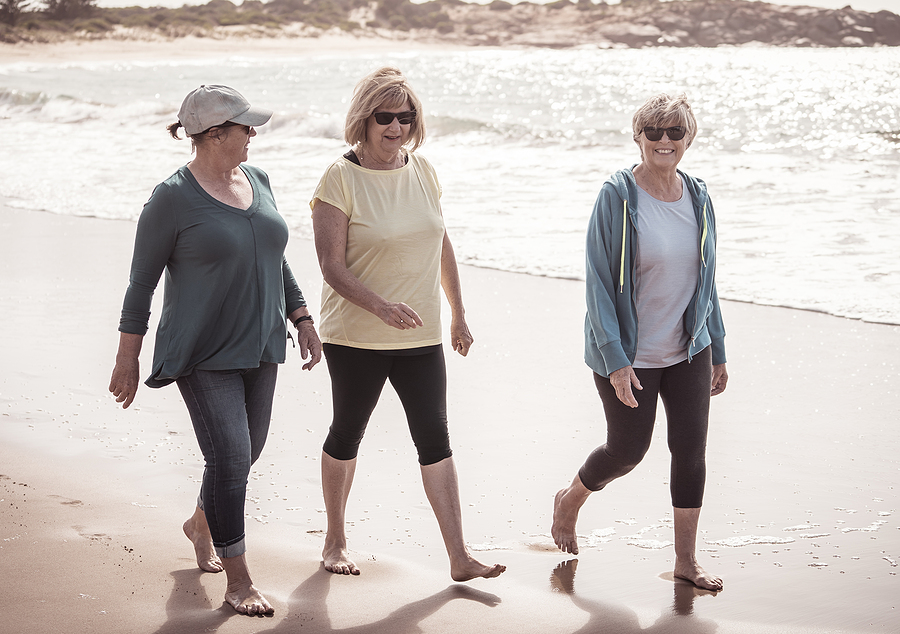That’s the title of a recent book by Melbourne medical professor Cassandra Szoeke. After 30 years of collecting and analyzing data on women’s health, here are some of her key observations.
The study she oversees is called the Women’s Healthy Ageing Project (WHAP). When it started in 1990 participants were aged 45 to 55. Now they’re 75 to 85, and the work involved in tracking their health has yielded these important messages:
Think about today, tomorrow and the long haul
Chronic disease develops slowly.
For example, the plaque that’s a feature of dementia occurs three decades before we know we have it. It also takes decades for arteries to change such that we have a heart attack or stroke. What we do in our 40s, 50’s and 60s shows up after we’re 70.
“What you do today affects you today, tomorrow and over the next three decades at least, if not longer”, she says
There’s one thing you can do for your health each day. And it’s a walk in the park!
What this research tells us about exercise is that we need to keep on doing it. Information collected over several decades shows that women who do something every day have the best outcomes.
So rather than worrying about whether you should be doing high-intensity interval training, get out and go for a walk — every day for 30 (and more) years.
Yes, HIIT is beneficial. So is balance practice, and resistance training to maintain muscle and bone. The selections you make will depend on your needs and inclinations, but above all, do something.
Professor Szoeke suggests structuring activity into our daily lives, e.g. walking or cycling instead of driving or using the stairs rather than the lift. Fitness devices that record our activity can also prompt us to do more.
Other ways to weave activity into daily life could include walking the dog, gardening, vacuuming or other housework, walking to catch up with a friend, playing with grandchildren or doing voluntary work.
She also points out that being fit builds our capacity to weather the storms of life. Fitter women tend to be more resilient.
The main argument for not exercising is invariably that it takes time, but her research shows that daily activity can increase our lifespan by seven years. In the long run it gives us time — years in fact.
It’s all connected
While our medical system focuses on single diseases, our bodies don’t work that way.
As she says, our heart, brain, liver and stomach are all in the one body, so treatments for one will affect the others in some way.
For example, low levels of vitamin D and calcium cause bone changes and disease. This causes inflammation in the body, and that inflammation can impact other organs, such as the brain. Even arthritis can, over the years, produce enough inflammation to affect the brain.
She also argues that having high HDL (‘good’) cholesterol protects women’s brains, but cholesterol is generally only discussed in relation to heart disease, where the focus is usually on lowering LDL rather than boosting HDL.
So what are the ‘secrets’ of women’s healthy ageing?
What’s important, Professor Szoeke says, is that we protect our body, heart and brain every day because our cells are constantly turning over and remodeling.
The six key things to aim to do forever are:
- Move as much as possible — every day
- Stay engaged with other people
- Be mindful of what you eat and eat well
- Challenge your brain
- Sleep well
- Don’t smoke, drink to excess or take non-prescription drugs.
Want to get involved in her research?
Professor Szoeke and her team have created a new online study called ‘ageHAPPY’ which is open to all adults, men and women (In 2016, for example, 22,000 people aged 18-98 took part.)
It involves completing an annual survey that takes 30-45 minutes, but you can do it in short blocks of time.
After you’ve done the survey you’ll get an email asking whether you’d like to participate in some brain games that take about 30 minutes, but again you don’t have to do it all at once.
Then in a year’s time you’ll get an invitation to do it all again. It’s a way to contribute to research and learn about yourself at the same time.
Photo Source: Bigstock

